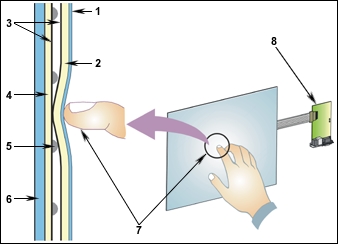How does a touch screen work?

Touch screens are a relatively new form of technology that has seen immense growth over the past few years. With smartphones, e-readers, and interactive displays replacing the traditional desktop computers, books, and signs, consumers now expect and rely on the convenience and ease of touch screen technology. And you can purchase many different types at your reliable supplier, RS Components.
To understand why touch screen technology is so popular, and how it can benefit your business, you might want to know how it all works.
Types of touch screen technology
You may be aware that different types of touch screen technology exist. You may have noticed that you can interact with your finger, but other objects like pens don’t have any effect. Similarly, you may use a stylus to swipe through a book on your e-reader, while your finger doesn’t do the trick.
This is because different touch screen types require different inputs to work correctly.
There are five main types of touch screen technology on the market today:
- Resistive
- Surface capacitive
- Projected capacitive
- Infrared
- Surface Acoustic Wave (SAV)
In today’s world, resistive and capacitive touch screen technologies are the most common. You’ll find resistive technology used for supermarket kiosks and ATMs, while capacitive touch screens are used for smartphones and most tablets.
Resistive and capacitive touch screens
Most modern touch screens use either resistive or capacitive technology.
Resistive touch screens feature two flexible, narrow metallic layers separated by a small gap. One layer is conductive and the other is resistive. When a finger, stylus, pen, or other object comes into contact with the screen, these gaps close, and the electrical current will change. The device software will recognise this change at the point of contact, signaling the appropriate response (such as a click or swipe).
Resistive screens are a versatile and low-cost option for businesses looking to invest in touch screen technology.
Capacitive touch screens feature a see-through electrode layer. Below this electrode layer sits a glass panel, and a protective layer covers them both.
This type of technology works with any object holding an electrical charge, such as a human finger or an electrically charged stylus. When you touch the screen, it will detect a change in electrical current.
Businesses may choose capacitive technology over resistive technology because of its improved durability.
Projected capacitive touch screens differ slightly from standard capacitive touch screens. While typical surface capacitive screens feature a thin, evenly distributed film across their surface, projected capacitive screens use a grid of column and rows and a separate chip.
Both projected and surface capacitive touch screens produce a clearer image than resistive touch screens.
Infrared and Surface Acoustic Wave (SAV)
Infrared technology uses a grid of light-detecting photocells and LEDs situated on opposite sides of the monitor. The LEDs shine infrared lights across the screen. When your finger touches the screen, it can break through these beams, revealing the point of touch to the screen’s in-built microchip. Some e-readers use infrared touch screen technology.
SAV technology is similar to infrared, but it uses sound waves rather than light. Ultrasonic waves move back and forth across the screen’s surface, and when you interrupt these beams with your finger, the screen’s microchip will detect the point of touch.
Conclusion
Five types of touch screen technology exist today, including resistive, surface capacitive, projected capacitive, infrared, and Surface Acoustic Wave (SAV). Each of these technologies work differently and respond to unique inputs.





